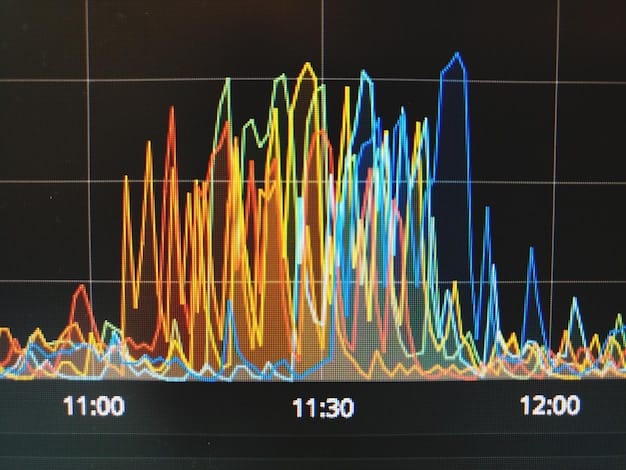US Consumers & Metaverse: Adoption Trends and Insights

US Consumers and the Metaverse: Adoption Rates and Key Trends to Know explores the current level of adoption among US consumers, identifies emerging trends shaping its use, and provides insights into future growth potential.
The metaverse, once a futuristic concept, is gradually becoming a reality, capturing the attention of consumers worldwide. This article delves into US Consumers and the Metaverse: Adoption Rates and Key Trends to Know, offering insights into how Americans are embracing this digital frontier.
Understanding the Metaverse: A Brief Overview
Before diving into the adoption rates and trends, it’s crucial to understand what the metaverse entails. In essence, the metaverse is a network of 3D virtual worlds focused on social connection.
It’s important to note that the metaverse is not a single entity, but rather a collection of virtual experiences, platforms, and technologies.
Key Components of the Metaverse
The metaverse encompasses several core elements that contribute to its immersive and interactive nature. These elements include:
- Virtual Reality (VR): VR technology provides users with immersive experiences, allowing them to interact with the digital environment through headsets and controllers.
- Augmented Reality (AR): AR overlays digital information onto the real world, enhancing the user’s perception and interaction with their surroundings.
- Blockchain Technology: Blockchain plays a critical role in enabling digital ownership, decentralized governance, and secure transactions within the metaverse.
- Artificial Intelligence (AI): AI powers various aspects of the metaverse, including avatar creation, content generation, and personalized experiences.
Ultimately, the metaverse aims to blur the lines between the physical and digital worlds, offering users new ways to connect, create, and explore.

Adoption Rates of the Metaverse Among US Consumers
Understanding the current adoption rates of the metaverse among US consumers provides valuable insights into the technology’s potential and trajectory. While still in its early stages, the metaverse is gradually gaining traction among various demographic groups.
Several factors influence the adoption rates, including awareness, accessibility, and perceived value.
Factors Influencing Adoption Rates
A range of factors plays a role in determining how quickly US consumers embrace the metaverse. These factors include:
- Technological Advancements: Ongoing advancements in VR/AR technology make the metaverse more immersive and accessible.
- Content and Experiences: The availability of engaging content and experiences, such as gaming, social events, and virtual concerts, drives adoption.
- Economic Opportunities: The potential for earning revenue through virtual assets, NFTs, and metaverse-based jobs attracts users.
Currently, younger generations, particularly Gen Z and Millennials, are leading the charge in metaverse adoption, followed by Gen X and Baby Boomers.
Emerging Trends Shaping the Metaverse Experience
Several emerging trends are shaping how US consumers interact with and experience the metaverse. These trends include a greater focus on social interaction and a wider range of applications across industries.
The convergence of these trends will further accelerate the development and adoption of the metaverse, creating new opportunities and possibilities.
Social Interaction and Community Building
Social interaction is becoming a central aspect of the metaverse, with users seeking opportunities to connect with friends, family, and like-minded individuals. As such, several features have increased in use, including:
- Virtual Events and Gatherings: The metaverse is hosting an increasing number of virtual events, such as concerts, conferences, and parties.
- Avatar Customization and Identity: Users are investing time and effort in creating unique avatars that represent their digital identities.
- Social Commerce and Virtual Shopping: Brands are leveraging the metaverse to create immersive shopping experiences and facilitate social commerce.
The social dimension is driving a sense of community and belonging within the metaverse, fostering engagement and loyalty among users.
Metaverse Applications: Beyond Gaming and Entertainment
While gaming and entertainment were early drivers of metaverse adoption, the technology is finding applications across various industries, including education, healthcare, and commerce.

These applications demonstrate the versatility and transformative potential of the metaverse.
Expanding Use Cases in Key Industries
The applications of the metaverse extend far beyond entertainment, as businesses and organizations explore its potential in:
- Education and Training: Virtual classrooms, simulations, and immersive learning experiences are revolutionizing education and training programs.
- Healthcare and Telemedicine: The metaverse is enabling remote consultations, virtual therapy, and immersive rehabilitation programs.
- Commerce and Retail: Brands are creating virtual storefronts, immersive product experiences, and metaverse-based marketing campaigns.
As the metaverse continues to evolve, we can expect to see even more innovative applications emerge in various sectors.
Challenges and Opportunities in the US Metaverse Market
Despite the numerous opportunities presented by the metaverse, significant challenges remain in the US market. Addressing these challenges is crucial for unlocking the full potential of the metaverse and ensuring its long-term success.
The ongoing collaboration among stakeholders is essential for creating a safe, inclusive, and thriving metaverse ecosystem.
Key Challenges in Metaverse Adoption
Several key challenges need to be addressed to facilitate widespread metaverse adoption in the US. These include:
- Privacy and Security Concerns: Protecting user data and ensuring secure transactions within the metaverse is paramount. Regulation is needed.
- Accessibility and Digital Divide: Ensuring that the metaverse is accessible to all, regardless of socioeconomic status or geographic location, is crucial.
- Ethical and Social Implications: Addressing potential ethical concerns related to virtual identity, data ownership, and content moderation is essential.
By proactively addressing these challenges, the US can foster responsible and sustainable growth for the metaverse.
Looking Ahead: The Future of the Metaverse for US Consumers
The future of the metaverse for US consumers is bright, with continued technological advancements, expanding use cases, and growing adoption rates expected in the coming years.
The convergence of these factors will shape the evolution of the metaverse and its impact on society. Let’s take a look at some of those factors:
Factors Shaping the Metaverse’s Future
Several factors will play a key role in shaping the future of the metaverse in the US. These include:
- Technological Innovation: Continued advancements in VR/AR technology, AI, and blockchain will drive innovation within the metaverse.
- Evolving Consumer Preferences: Shifting consumer preferences for immersive experiences, social interaction, and digital ownership will influence metaverse adoption.
- Regulatory Landscape: Clear and consistent regulations regarding data privacy, security, and virtual asset ownership will provide a framework for responsible growth.
As the metaverse continues to evolve, it has the potential to transform how we live, work, and interact with each other.
| Key Point | Brief Description |
|---|---|
| 🚀 Metaverse Adoption | Growing, especially among younger generations, across various platforms. |
| 🎮 Beyond Gaming | Expanding into education, healthcare, retail, and more. |
| 🔒 Challenges | Addressing privacy, accessibility, and ethical concerns is crucial. |
| 🌐 Future Growth | Driven by tech innovation, evolving consumer behavior, and clear regulations. |
FAQ
▼
The metaverse is a network of 3D virtual worlds focused on social connection. It isn’t a unitary platform but rather a collection of interconnected digital environments and experiences.
▼
Younger generations, particularly Gen Z and Millennials, are the most active users in the metaverse. They are more likely to engage with virtual experiences and digital communities.
▼
Key challenges include privacy and security concerns, accessibility and the digital divide, and ethical implications related to virtual identity and data ownership.
▼
Blockchain technology enables digital ownership, decentralized governance, and secure transactions within the metaverse. It supports virtual assets, NFTs, and metaverse-based economies.
▼
Beyond gaming, the metaverse is finding applications in areas like education (virtual classrooms), healthcare (telemedicine, therapy), and commerce (virtual storefronts, marketing campaigns).
Conclusion
In summary, the metaverse is rapidly evolving, driven by technological innovation, changing consumer preferences, and a regulatory environment that is beginning to take shape. While challenges remain, the opportunities for businesses and consumers alike in the US market are substantial in the coming years.





